Which Circle of Hell? The Textual Journey Through Dante’s Inferno
- Elaine Harrington
- February 20, 2014
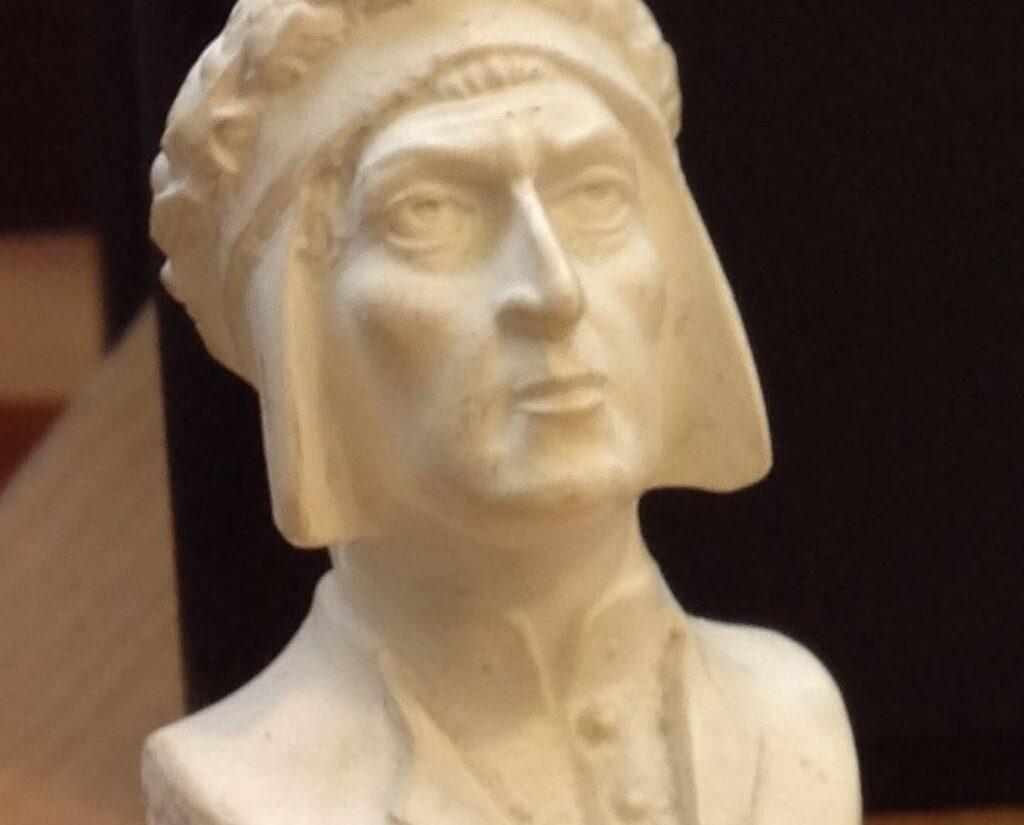
To complement the current exhibition in UCC Library, Dante Alighieri Inferno: A Suite of Lithographs by Liam Ó Broin, Special Collections has organised a selection of material from the collections and on loan from the Department of Italian. Material in the exhibition cases is taken from the following collections: Older Printed Books, Ó Riordáin Collection, Cork University Press, and the X Collection.
Dante & the Department of Italian
The first exhibition case introduces us to links that the Department of Italian have had with Dante over the years.
Professor Mary Ryan was Professor of Romance Languages in UCC from 1919 – 1938. She was the first woman professor in Ireland and Great Britain. On display is her copy of La Divina commedia di Dante Alighieri with commentary by Scartazzini (Milano: Hoepli: 1896). This book was bought by Prof. Ryan in Florence in 1897. The book is open to show her signature.
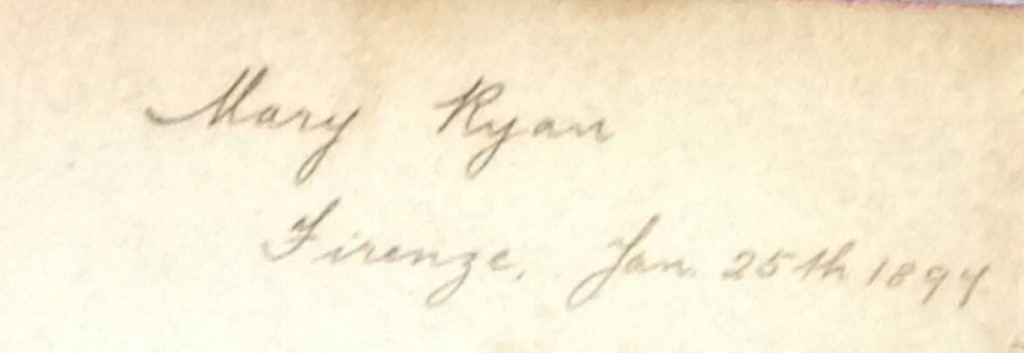
In his writings James Joyce used an earlier edition (1891) of the Scartazzini edition that Prof. Ryan owned. In addition there is a photograph of Professor Ryan.
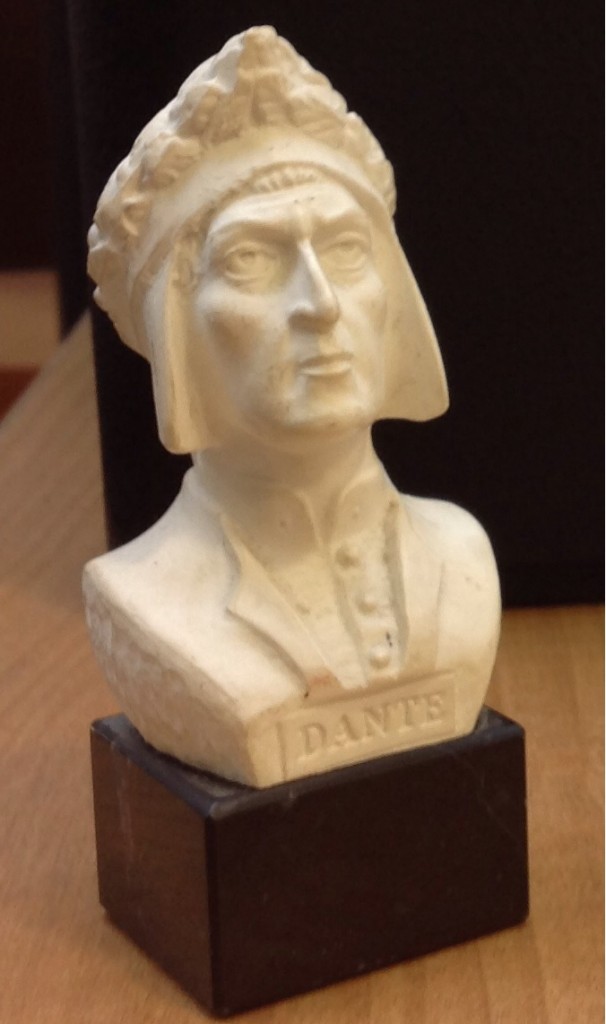
There are three different images of Dante in differing formats, a bust of Dante and a free standing plaque, a lauro dantesco. The bust has been kindly lent by Dr Daragh O’Connell. The plaque was given to Prof. O’Brien some years ago for lectures given in Ravenna on Dante and Irish literature. Prof. Catherine O’Brien previously worked in UCC for many years. Lastly an image of Dante and Beatrice meeting at the bridge in Florence. This image had belonged to Professor Ethna Byrne Costigan. Prof. Byrne Costigan was appointed professor of Romance languages at UCC following the retirement of Prof. Ryan in 1938 and remained in this post until 1969. Prof. Byrne Costigan has collections in both Special Collections and the Archives Service in UCC Library.
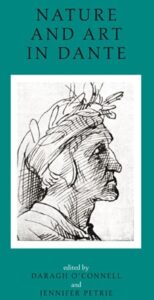
In addition there are two publications from the Department of Italian. The first is: Daragh O’Connell & Jennifer Petrie’s recent publication: Nature and Art in Dante: Literary and Theological Essays. O’Connell & Petrie’s edited collection explores Dante’s use of art; Dante’s pronouncements on his own aesthetic practice; the blending of visual art, poetry, drama and music; poetry, and the figure of the Christian hero; Dante’s art of the simile and its relevance to the wider implications of the metaphor of the poem as ship. In addition there are essays with a more theological approach: the interrelated concepts of nature, art and divine creation in the context of medieval thought; divine art in the bas-reliefs of Purgatorio x, and the significance of the vernacular for Dante as the most embodied and expressive, and so most fully human, form of language.
The last item with links to the Department of Italian is Piero Cali’s book, Allegory and Vision in Dante and Langland. This was published by Cork University Press in 1971. Dr Cali had come to Cork as the first lecturer in the Department of Italian. Both he and Prof. Byrne Costigan founded the Dante Alighieri Society in Cork. Prof. Byrne Costigan served as president of the Society from 1956 to 1969.
In this case also is an image of Dante meeting Virgil.
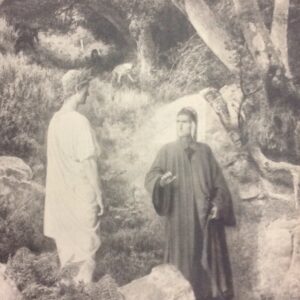
This image is in La Divina commedia: novamente illustrata da artisti italiani, curated by Vittorio Alinari. The book is part of a three volumed set, one volume for each section of the Commedia. Volume I was published in 1902 and contains the Inferno. Volume II contains the Purgatorio and Volume III contains the Paradiso; both were published in 1903. The illustrations are accompanied by the Italian text. This volume is bound in the style of Queen’s College Cork (QCC) with a QCC stamp on the title page, a QCC bookplate on the front endpapers and QCC logo gold tooled on the spine. This volume is half bound in red leather with gold tooling on spine and marbled boards.
Dante: The Text
The second exhibition case contains texts in Irish, English and Italian as well as original drawings.
Pádraig de Brún’s dual language edition of Dante’s Inferno: Coiméide dhiaga Dante: Leabhar I. On one page is the Italian text and on the facing page the Irish translation. de Brún uses features which are not peculiar to Irish but are features of Dante’s style. These include inversion and extended similes. The poem is to be read as a unit; there are no footnotes on each page, instead there are notes at the end of the text. Adjacent to the de Brún work is Carson’s modern day translation. In 2004 the Belfast poet and novelist Ciarán Carson translated Dante Aligheri’s Inferno. Carson inserts archaisms from 18th-century Irish ballads into the text. He has chosen to work within Dante’s terza rima which is a fiendish triple rhyme.
Special Collections is privileged to hold the first English translation of The Divina Commedia of Dante Alighieri: Consisting of the Inferno — Purgatorio — and Paradiso. This was written by Henry Boyd in 1802. Boyd (1748/9-1832) was a translator and Church of Ireland clergyman, born in Dromore, Co. Antrim. His translation was the first complete edition of the Divine Comedy to be published in English and was important for “assisting to re-establish an audience for Dante, whose reputation had suffered a decline in the previous century” (Oxford Dictionary of National Biography). Boyd intended to make the work accessible to a contemporary audience and the editorial choices and translated verse style that he adopted to help achieve this accessibility have been criticised by later commentators. However without them his work would probably have failed to have had the impact that it did. To his translation Boyd added extensive essays and notes as well as a translation of Leonardi Bruni’s Life of Dante. He dedicated the work to Viscount Charleville whom he had for years served as chaplain.
The volumes are half bound in red morocco and black cloth. Volume 3 contains an index of the most remarkable characters in the poem. The language is noticeably different to Carson’s and features of the printing are evident in the catchwords at the foot of the page alerting the binder to which page is next.
Alongside Boyd’s translation is a mid-19th century Italian edition. This is Giannini’s Commento di Francesco da Buti sopra La divina comedia di Dante Allighieri. Giannini provides a commentary canto by canto. The volumes are half bound in leather with gold tooled (QCC) crest on spine and marbled boards. There is a (QCC) bookplate on the front endpapers and a (QCC) stamp on the title page.
Both Boyd’s translation and Giannini’s volume show the first lines to Dante Alighieri’s Inferno.
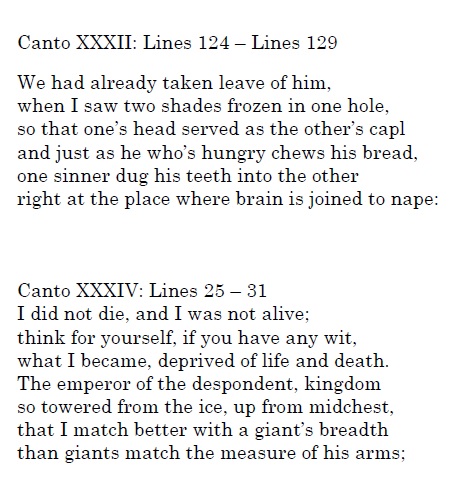
and Canto XXXIV: Lines 25 – 31. Mandelbaum, Allen, trans. The divine comedy of Dante Alighieri.
The last volume in the exhibition shows illustrations for specific lines of Canto XXXII and Canto XXXIV which are given in the figure to the left. Barry Moser, the well-known printmaker produced 90 pen and wash drawings to accompany the work in Mandelbaum’s volume. Allen Mandelbaum was one of the premier translators of Italian and classical poetry. Mandelbaum also translated Virgil’s The Aenid, Homer’s Odyssey and Ovid’s Metamorphoses.
Listen to Liam Ó Broin & Daragh O’Connell give an introduction to the exhibition.
Acknowledgements
Bust of Dante. On loan from Dr. Daragh O’Connell.
Dante meeting Beatrice at the bridge in Florence. On loan from Prof. Catherine O’Brien, formerly of UCC.
Free standing plaque, a lauro dantesco. On loan from Prof. Catherine O’Brien, formerly of UCC.
Scartazinni, G.A., comment. La Divina commedia di Dante Alighieri. Milano: Hoepli, 1896. On loan from Prof. Catherine O’Brien, formerly of UCC.
Dante Alighieri, and Ciarán Carson. The Inferno of Dante Alighieri: A New Translation. London: Granta, 2002. On loan from Crónán Ó Doibhlin.
References
Alinari, Vittorio, a cura. La Divina commedia: novamente illustrata da artisti italiani. Firenze: Fratelli Alinari, 1902-03.
Boyd, Henry, trans. & illus. The Divina Commedia of Dante Alighieri: Consisting of the Inferno — Purgatorio — and Paradiso. London: T. Cadell jun. and W. Davies, 1802.
Cali, Pietro. Allegory and Vision in Dante and Langland. Cork: Cork U.P., 1971.
Dante Alighieri and Pádraig De Brún, trans. Coiméide dhiaga Dante: Leabhar I. Baile Átha Cliath [Dublin]: Mac An Ghoill, 1963.
Dante’s Inferno: Liam Ó Broin & Daragh O’Connell introduce Dante’s Inferno. http://www.youtube.com/watch?v=xW00R8Xtric
Giannini, Crescentino, a cura. Commento di Francesco da Buti sopra La divina comedia di Dante Allighieri. Pisa: Pei Fratelli Nistri, 1858.
Mandelbaum, Allen, trans. The divine comedy of Dante Alighieri. A verse translation with introduction and commentary by Mandelbaum; drawings by Barry Moser. Berkeley: California U.P., 1980.
Matthew, HCG and Brian Harrison, eds. Oxford Dictionary of National Biography: in association with the British Academy : from the earliest times to the year 2000. Oxford; New York: Oxford UP, 2004.
O’Connell, Daragh and Jennifer Petrie, eds. Nature and Art in Dante: Literary and Theological Essays. Dublin: Four Courts P, 2013.
Comments are closed.
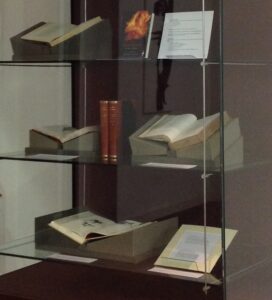

[…] Dante’s Inferno (Dept. of Italian with Dr Daragh O’Connell) […]